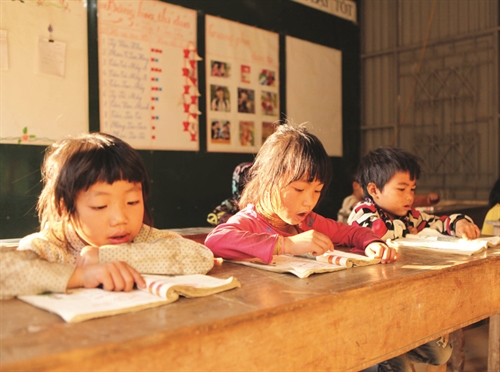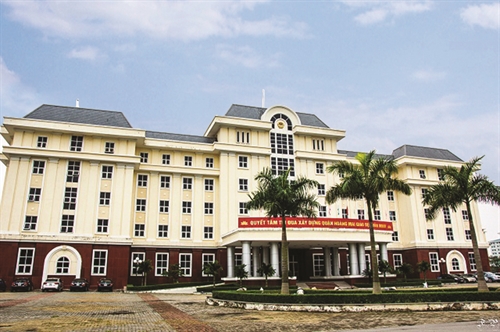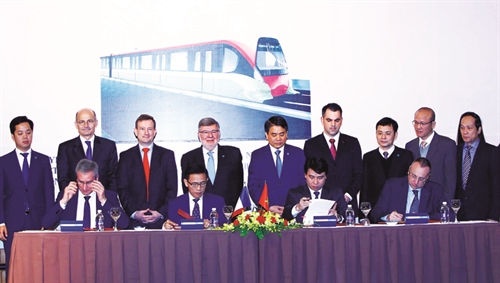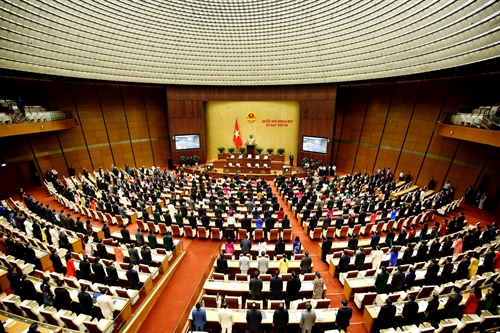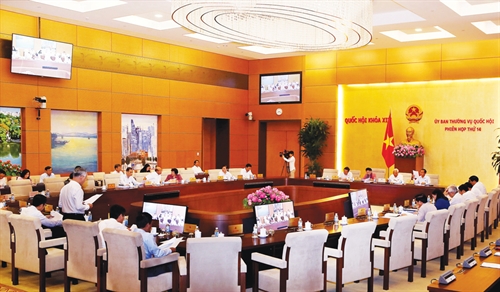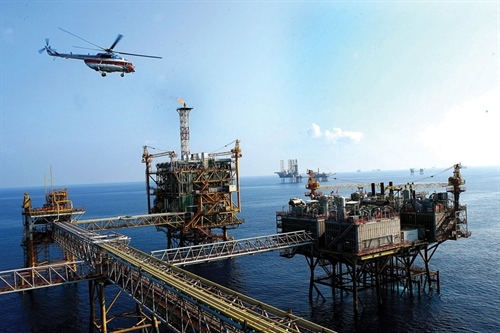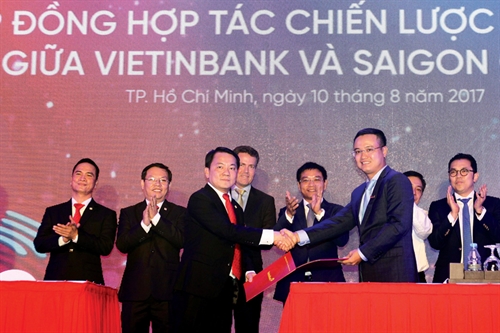Guiding viewpoints
The renovation and restructuring of the political system apparatus must be conducted on the principles of enhancing the Party’s leadership and the State’s management and promoting the role of the Fatherland Front and socio-political organizations and the right to mastery of the people. It must closely follow the Constitution as well as the Party’s Political Platform, Charter and documents and be incorporated in the overall task of Party building and rectification and carried out in tandem with economic renewal, meeting the requirements of building and perfecting the law-ruled socialist state, developing the socialist-oriented market economy and international integration.
In the course of restructuring the political system apparatus, the organizational and operational principles of the Party must be upheld while the Party’s rules and discipline as well as the State’s laws must be strictly observed. The renovation, restructuring and management of the apparatus and personnel of the political system will be led and directed by the Party Central Committee while drawing on the activeness, proactiveness and creativeness of each level of administration, sector and locality.
The renovation and restructuring of the political system apparatus must be comprehensive and synchronous, harmoniously combining inheritance and stability with renovation and development. Organizational renovation must be associated with renovation of leadership methods, staff reduction and salary reform. Arrangement of sufficient resources and adoption of appropriate policies and mechanisms are needed to attract virtuous and talented persons as well as helping persons affected by the renovation and restructuring process.
The apparatus renovation and restructuring must be carried out in a regular, continuous, active and vigorous manner with focuses and priorities, clear roadmaps and firm steps to meet both immediate and long-term requirements.
Prompt actions must be taken on issues that are clear and ripen. For new issues, pilot implementation is needed to draw experiences, avoiding perfectionism as well as hastiness. For unclear, complicated, sensitive or controversial issues, study and review should be done to reach suitable policies and solutions.
The apparatus renovation and restructuring must adhere to the principle that one agency can assume many tasks but one task must be assigned to only one agency. The model and size of the apparatus of an agency, a unit or a local administration must suit its nature, characteristics, functions and tasks.
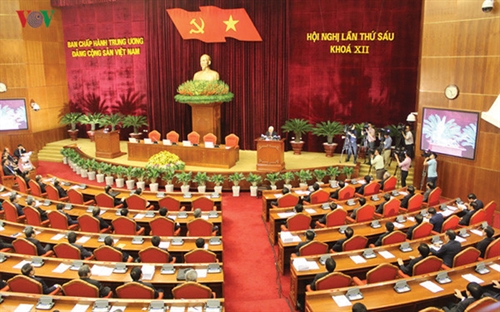 |
The closing session of the 6th plenum of the Party Central Committee (the 12th Congress) in Hanoi__Photo: Phuong Hoa/VNA |
Overall objective
To continue to renovate and restructure the political system apparatus for effective and efficient operation in conformity with the socialist-oriented market economy institutions with the aim of enhancing the Party’s leadership, raising the effectiveness and efficiency of the State’s management and operational quality of the Fatherland Front and socio-political organizations, and promoting the people’s role as masters. To combine staff reduction with restructuring and improving the quality and effectively using the contingent of cadres, civil servants and public employees, cutting down current expenditures and reforming salary policy.
Objectives through 2021
(1) To basically complete the reorganization and strengthening of a number of organizations and their internal units in the direction of reducing the number of internal units, minimizing intermediary levels and reducing the number of deputy heads. To revise regulations on the functions, tasks and apparatus of the political system in order to promptly redress existing overlaps;
(2) To implement on a pilot basis some new organizational models and the concurrent holding of several positions for preparing clear theoretical and practical grounds;
(3) To rationally merge commune-level administrative units with a population and land areas not reaching 50 percent of the set standards, and reduce the number of hamlets and street groups; and,
(4) To reduce the state payroll by at least 10 percent compared to the 2015’s figure.
Objectives for 2021-30
(1) To complete the study and apply the overall organizational model for the political system in conformity with Vietnam’s requirements and specific conditions in the new period; to reduce the state payroll;
(2) To clearly define the functions, tasks and powers of each agency or organization in the political system, ensuring neither overlap nor omission of any function and task;
(3) To continue to translate the Party’s guidelines, resolutions and conclusions on organizational renovation and restructuring into regulations of the Party and laws of the State;
(4) To establish and apply different models of local administration in rural, urban and island areas and special administrative-economic units; and,
(5) To basically finish the merger of district- and commune-level administrative units, hamlets and street quarters according to the set standards.
For public non-business units, from now to 2030, they will be reorganized and improved according to the roadmap, objectives and solutions set forth in the Resolution adopted at the 6th plenum of the 12th Party Central Committee on “Further renovating the organization and management of public non-business units for better quality and more effective operation.”
Major tasks and solutions
 |
Dr Nguyen Viet Thao from Ho Chi Minh National Academy of Politics addresses the inaugural ceremony of political theory courses for officials of central agencies__Photo: Internet |
For the entire political system
To expeditiously study, complete and apply the overall organizational model of the political system to meet the requirements of building and consolidating the law-ruled socialist state, developing the socialist-oriented market economy, and proactive and active international integration.
To scrutinize, restructure, consolidate and reduce units within organizations of the political system in association with downsizing and restructuring and raising the quality of the contingent of cadres, civil servants and public employees. To resolutely reduce the number of intermediary organizations and refrain from establishing new ones. To dissolve or reorganize organizations that are operating inefficiently.
The apparatus reorganization must not lead to an increase in the number of departmental and sectional units and staff. In special cases where it is necessary to increase the number of departmental or higher-level units, the Political Bureau’s opinion is required.
To review, supplement and improve the functions, tasks and powers of and working relationships among organizations within the political system, overcoming overlaps so that one organization or person may undertake different tasks but one task must be assigned to only one organization or person.
To reduce staff strictly according to the set target.
To prescribe and strictly manage payrolls of organizations within the political system on the basis of classifying these organizations, defining criteria for titles of cadres, civil servants and public employees, and determining working positions in a scientific and practical manner.
To fix the minimum number of staff needed for the formation of an organization and the maximum number of deputy heads of an organization suitable to the characteristics of each level, sector and locality. To reduce the rate of service staff, especially office staff, in each agency.
To review and revise the Party’s and the State’s regulations on organizational apparatuses of different levels, sectors and localities, ensuring synchronism and uniformity. To pilot several new models of streamlined apparatus and concurrent holding of several titles in order to reduce the number of organizations and raise their operational effectiveness and efficiency. To conduct timely reviews and step by step expand the application of suitable and efficient models.
To develop and apply the mechanism of fair, public, transparent and democratic competition in the appointment and promotion of officials and recruitment of civil servants and public employees in order to attract truly virtuous and talented persons to work in the political system.
To review and renovate the examination-based recruitment, appointment, employment, evaluation of and apply preferential policies to cadres, civil servants and public employees.
To step up salary reform.
To strictly implement regulations on dismissal, resignation and replacement of persons who are weak in capability and ethics, fail to meet the requirements and criteria of their titles or to accomplish their assigned tasks.
To further renovate the contents and methods of training cadres, civil servants and public employees.
To rationally and vigorously divide and decentralize powers between the central and local levels, between superiors and subordinates, linking powers to responsibility. At the same time, to develop a mechanism for tight control of power by means of the Party’s regulations and the State’s laws, ensuring democracy, publicity and transparency, heightening accountability and intensifying inspection and supervision. To encourage dynamism and creativity and promote the activeness and proactiveness of authorities, sectors and localities in streamlining their apparatus and reducing staff.
To develop specific and practical programs and plans so as to facilitate the leadership, direction, examination, inspection and supervision of the implementation of regulations on apparatus streamlining and staff reduction in the political system.
Apparatus streamlining and staff reduction will be regarded as an important criterion for evaluation, election, appointment or dismissal of officials.
To continue with vigorous administrative reforms, intensively and extensively apply science and technology, particularly information technology. To accelerate the building of an e-government and smart cities. To conduct reviews and evaluations in order to work out measures to efficiently use information technology infrastructure, contributing to apparatus streamlining and staff reduction.
To make adequate investments in scientific research in the organization and personnel of the political system.
To study and revise regulations on allocation of state budget funds for organizations, agencies and units in the political system.
For the organizational system of the Party
To terminate the operation of the Steering Committees for Northwest, Central Highlands and Southwestern regions.
To reorganize the Party organization of Overseas Representative Missions and the Party organization of the Ministry of Foreign Affairs toward observing general regulations while ensuring their particularities in order to enhance Party building work and improve leadership capacity and combativeness of overseas Party organizations.
To transfer the Office of the Central Judicial Reform Steering Committee to the Internal Affairs Commission of the Party Central Committee and reorganize it properly.
To revise the functions, tasks, powers, responsibilities and working relations of Party committees in charge of state agencies toward streamlining their apparatuses and focusing on Party building tasks. To continue studying and reorganizing Party committees in charge of enterprises to suit new conditions at the central and local levels in order to raise their operational efficiency.
To renew and improve the model of Party organizations in state enterprises and public non-business units in order to enhance the Party’s comprehensive leadership and closely manage Party members.
To step up the building of Party organizations and development of Party members in private enterprises and non-business units.
To merge Party Committee offices with the offices of the People’s Councils and the People’s Committees in district-level administrative units where conditions permit.
To implement on a trial basis the concurrent holding of multiple leadership titles or merge a number of Party and State agencies or Party and Fatherland Front agencies with similar functions and tasks at provincial and district levels in localities where conditions permit.
To basically apply the model of Party Committee secretary cum People’s Council chairman at different levels and the model of Party Committee secretary-cum-People’s Committee chairperson in commune- and district-level administrative units where conditions permit.
For state agencies at central level
To increase the proportion of full-time National Assembly deputies while rationally cutting down the number of National Assembly deputies working in executive agencies. To set rational proportions of leaders, standing members and full-time members of the Ethnic Council and Committees of the National Assembly toward trimming the numbers of deputy heads and standing members. To reduce the units within the Office of the National Assembly.
The Government, ministries and ministerial-level agencies will further renovate, consolidate, reorganize their apparatuses toward concentrating on macro-management and formulation of strategies, master plans, plans, laws, mechanisms and policies, building their direction and administration capacity and intensifying examination and inspection work.
To expeditiously review and revise the functions, tasks, powers, responsibilities and working relationships between ministries and sectors and their respective attached organizations. To determinedly redress overlapping functions and tasks to make sure that one organization can assume multiple tasks but one task must be assigned to only one organization. To scrutinize and reduce inter-sectoral coordinating organizations, especially those having full-time assisting units.
Ministries, sectors and government-attached agencies will take the initiative in reviewing, reorganizing and restructuring their internal units, and slashing the number of general departments, departments and sections. To refrain from establishing new organizations and sections within departments, except special cases to be decided by competent authorities. To reduce to the utmost the number of project management units. To resolutely merge and reorganize public non-business units in order to downsize the apparatus and staff. To implement the mechanism of allocating package funds based on assigned tasks and output products. To transfer tasks and public administrative services which need not be performed by the State to enterprises and social organizations.
To review tasks and powers for vigorous and rational division and decentralization between the Government, ministries and sectors; between the Government, ministries and sectors and local administrations so as to contribute to apparatus and staff downsizing, higher operation efficacy and efficiency. To promote the proactiveness, creativity and sense of responsibility of each level and sector in association with power control.
To revise the Law on Organization of Local Administration, clearly defining the tasks, powers and responsibilities of administrations of provincial, district and commune levels and establishing the mechanism of power decentralization and authorization among local administrations of different levels.
To step up administrative reforms, especially administrative procedure reform in close combination with the organizational consolidation, reduction of internal units, abolition of intermediary levels and reduction of staffs of ministries, sectors, government-attached agencies.
Some hierarchically organized sectors such as tax, customs, state treasury and social security will be further reorganized through establishing inter-provincial or inter-district units.
To further clarify theoretical and practical grounds on the scope of multi-sector, multi-field management of a number of ministries and sectors, especially those with similar or overlapping functions and tasks such as transport and construction, finance and planning and investment, and ethnic minorities and religious affairs, so as to work out appropriate measures to consolidate, reorganize and reduce their internal units in the next term (2021-26).
To further study and incrementally reduce the number of investigating bodies to meet the requirements of criminal investigation, crime prevention and combat and conform with the organization and operation of the procuracy system and the court system in the spirit of judicial reform.
To review and revise the functions, tasks, powers, responsibilities, scope of operation and working relations of the State Audit Office of Vietnam and examination and inspection bodies of different levels in order to avoid their overlapping tasks.
For local administrations
To further revise regulations on building of local administrations in the direction of defining in a clearer manner the organizational apparatuses of administrations in urban areas and rural areas, on islands, and in special administrative-economic units and proactively apply these regulations in localities where conditions permit.
To reasonably reduce the number of People’s Council deputies and the number of People’s Council deputies working in state management agencies.
To cut down the number of deputy chairpersons of provincial- and district-level People’s Councils from the 2021-26 term.
To set the average numbers of agencies attached to provincial- and district-level People’s Councils and People’s Committees and of their deputy leaders. Based on these numbers as well as their specific conditions and criteria, local Party Committees will direct the appropriate reorganization of these agencies. To scrutinize and reorganize the units within provincial-level departments and sectors in the direction of reducing and reorganizing sections, sub-departments, centers, project management units and non-business units.
To review, adjust and reorganize the apparatus and operation mechanism of local administrations, contributing to vigorously accelerating administrative reform, especially reforming administrative procedures toward democracy, publicity, transparency and professionalism. To effectively implement the model of public administrative service centers and single-window and inter-agency single-window mechanisms at different levels.
To revise relevant legal documents to increase the operational effectiveness and efficiency of commune-level administrations and set a proper quantity of commune-level cadres and civil servants with clear positions and criteria.
To study and issue regulations on merger of the offices of the provincial-level People’s Council, National Assembly Deputies’ delegation and People’s Committee.
To incrementally reorganize district- and commune-level administrative units that have not yet attained law-prescribed standards. To encourage merger of these administrative units in areas where conditions permit in order to enhance their managerial capacity and make best use of local resources. To expeditiously and resolutely reorganize and merge hamlets and street quarters that currently fail to meet prescribed standards.- (VLLF)

